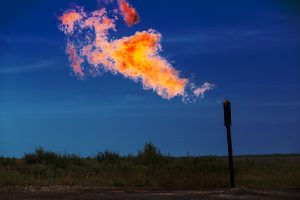
Monitor and Modeling in Permian Basin Show Sulfur Dioxide Levels High Enough to Trigger State and Federal Action
Watch MSNBC’s documentary on West Texas air pollution based on our report by clicking here.
Austin, TX – Illegal air pollution from the booming oil and gas industry in the Permian Basin is causing unhealthy air pollution levels in West Texas, but the state has not installed enough air quality monitors there to protect local residents, according to a new report by the Environmental Integrity Project.
Although the Permian Basin is the nation’s most prolific oil and gas producing region, it is home to only one air quality monitor for sulfur dioxide, which is released during the flaring of gas and can contribute to asthma and heart attacks.
Data from this lone monitor, located about 60 miles east of Odessa in Big Spring, exceeded national air quality standards for sulfur dioxide at least 30 times between December 2016 and April 2019, with the worst reading six times higher than the health standard, according to state records cited in the Environmental Integrity Project (EIP) report, “Sour Wind in West Texas.”
“Industrial air pollution in West Texas requires immediate action from state and federal regulators, and first and foremost better air quality monitoring to help protect public health,” said Ilan Levin, Texas Director of EIP and lead author of the report. “The growing number of oil and gas facilities are releasing vast amounts of sulfur dioxide and hydrogen sulfide, and either Texas or EPA needs to crack down on this hazard.”
EIP’s study used industry self-reported pollution data and an EPA-approved computer model to examine the impacts of unauthorized sulfur dioxide emissions in and around Ector County (which has 156,000 residents, including 117,000 in Odessa). The study demonstrates that flaring of “sour” gas (which smells like rotten eggs because it contains hydrogen sulfide) is causing dangerous levels of sulfur dioxide pollution in Ector County and Odessa.
According to EIP’s analysis, from 2014 through 2017, roughly 35 percent of Ector County experienced sulfur dioxide air pollution levels in excess of the level set by EPA as the National Ambient Air Quality Standard. By federal law, exceedances of these standards trigger a requirement for states to issue more stringent pollution control permits.
“The study confirms what I am experiencing living in the Permian Basin,” said Neta Rhyne, a resident of the West Texas town of Toyahvale. “As a lung cancer survivor, I am especially concerned about the increasing air pollution, and this report should sound alarm bells for the state and federal environmental regulators. It’s time for them to wake up and do their jobs.”
Neil Carman, Clean Air Program Director for the Sierra Club Lone Star Chapter, said: “Texans deserve to be informed about the harmful pollutants the oil and gas industry is pumping into the air we breathe. It’s long past time for state and federal leaders to act to protect our communities from dangerous air pollution.”
The Midland-Odessa region is one of the fastest growing metro areas in the country, with roughly a quarter million residents living in close proximity to oil and gas infrastructure, but with little air monitoring. While the Houston region has about 60 active air quality monitoring stations, the Odessa-Midland region has three, only one of which measures sulfur dioxide.
Many of the West Texas oil and gas facilities that report unauthorized emissions are owned or operated by a handful of companies, according to the EIP report. The report lists and ranks the “top 10” worst companies and facilities in the Permian Basin that released the most unauthorized sulfur dioxide air pollution in 2017 (the most recent year available).
The company with the most emission that year was Occidental Permian, which owns 74 facilities that released 10.6 million pounds of sulfur dioxide during 500 incidents, according to a state database of emissions during accidental or “upset” incidents, including maintenance and shutdowns. The facility with the most unauthorized air pollution in 2017 was Occidental’s Sealy Smith Clearfork No. 7 site in Ward County, which released 6.8 million pounds of sulfur dioxide in 10 incidents, according to the state database.
EIP’s report recommends the following steps to better monitor and control air pollution in the Permian Basin:
- Texas should invest in the health of Permian Basin residents by installing a regional air quality monitoring network to measure pollution in the Midland-Odessa area.
- EPA should conduct its own investigation into whether air quality in the Permian Basin meets federal health-based National Ambient Air Quality Standards. If it region is in nonattainment, this would require stricter protections to improve air quality and human health.
- The Texas Commission on Environmental Quality (TCEQ) and the Railroad Commission of Texas (which regulates oil and gas operations) should more vigorously enforce state permitting rules for oil and gas operations, to ensure that the state only issue permits to facilities that can demonstrate that their emissions will comply with state and federal standards.
- TCEQ should crack down on illegal pollution in the Permian Basin by penalizing oil and gas companies for gas flaring that pollutants over permitted levels.
“Texas regulators must crack down on sulfur dioxide and other harmful air pollution from oil and gas drilling,” said Sharon Wilson, Earthworks Senior Organizer. “Unfortunately, in my experience reporting over 100 documented incidents of such pollution, the state has repeatedly failed to act. From losing complaints, to being unable to find the sites they are charged with monitoring, Texas regulators cannot be trusted with our health and safety.”
The Environmental Integrity Project is a nonprofit, nonpartisan organization based in Washington, D.C., and Austin, Texas, that protects public health and the environment by investigating polluters, holding them accountable under the law, and strengthening public policy.
###
Media contact: Tom Pelton, Environmental Integrity Project, (202) 888-2703 or tpelton@environmentalintegrityproject.org


